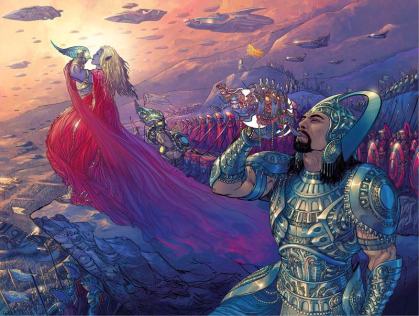
Artwork from “18 Days” by creators Grant Morrison and Mukesh Singh.
According to Ellen Lupton and Jennifer Cole Phillips in their book ‘Graphic Design The New Basics’, scaling (within the context of design) can be both subjective and objective. According to the two authors scaling is objective when the dimensions of an object are translated proportionately to either a larger or smaller size. For example, a city developer may create a model replica of a new development in a much smaller but proportionate size to that of the actual city development. Scaling is subjective when an artist uses size comparison and contrast to emphasize an object or deemphasized another, creating the impression that a certain aspect of an image is of greater importance.
The image above, taken from “18 Days” by Grant Morrison and Mukesh Singh, is an example of subjective scaling in that it shows what seems to be a male of some sort of royal status and a woman to his right (who seems to be his counterpart) with an army of soldiers behind them. The two are drawn much larger than the rest of the characters on the page, the male being larger than the female. This draws the viewers eye immediately to the male figure, then to the female just slightly in the distance, and finally to the rest of surroundings depicted in image, including army of soldiers behind them.
The positioning of the male and female within the frame is also important to the scale. The fact that the male is made larger than the other figures and details on the page, combined with his position in the bottom right corner of the page, in contrast to the woman who is positioned towards the top left corner and drawn slightly smaller in size implies to the viewer that the male in this image is of most significance.
